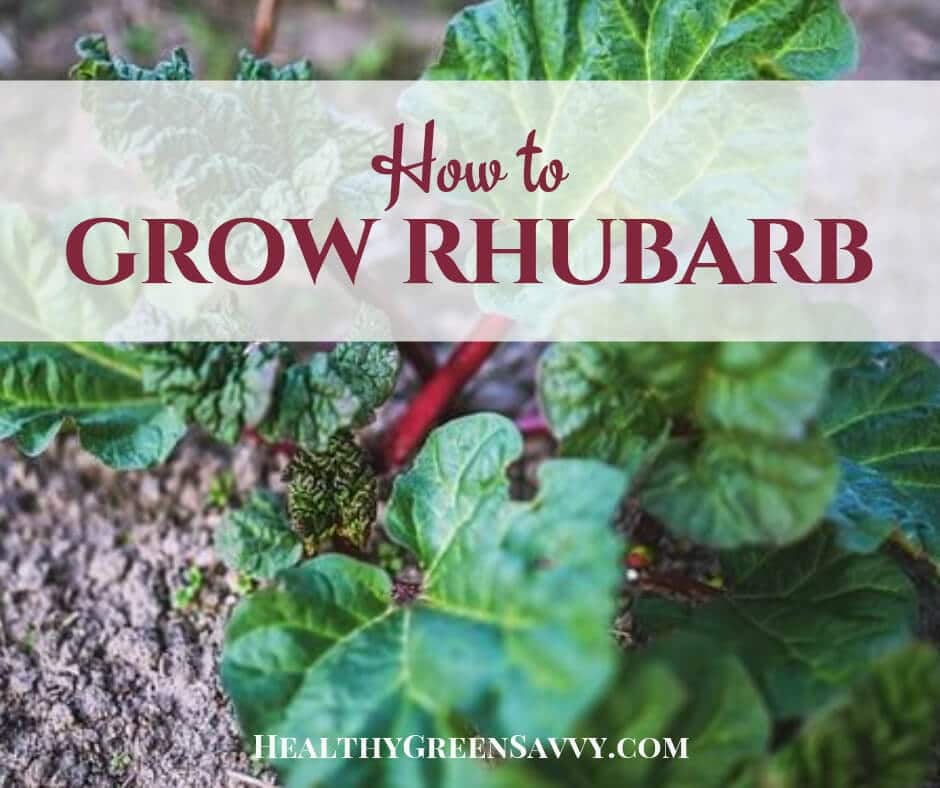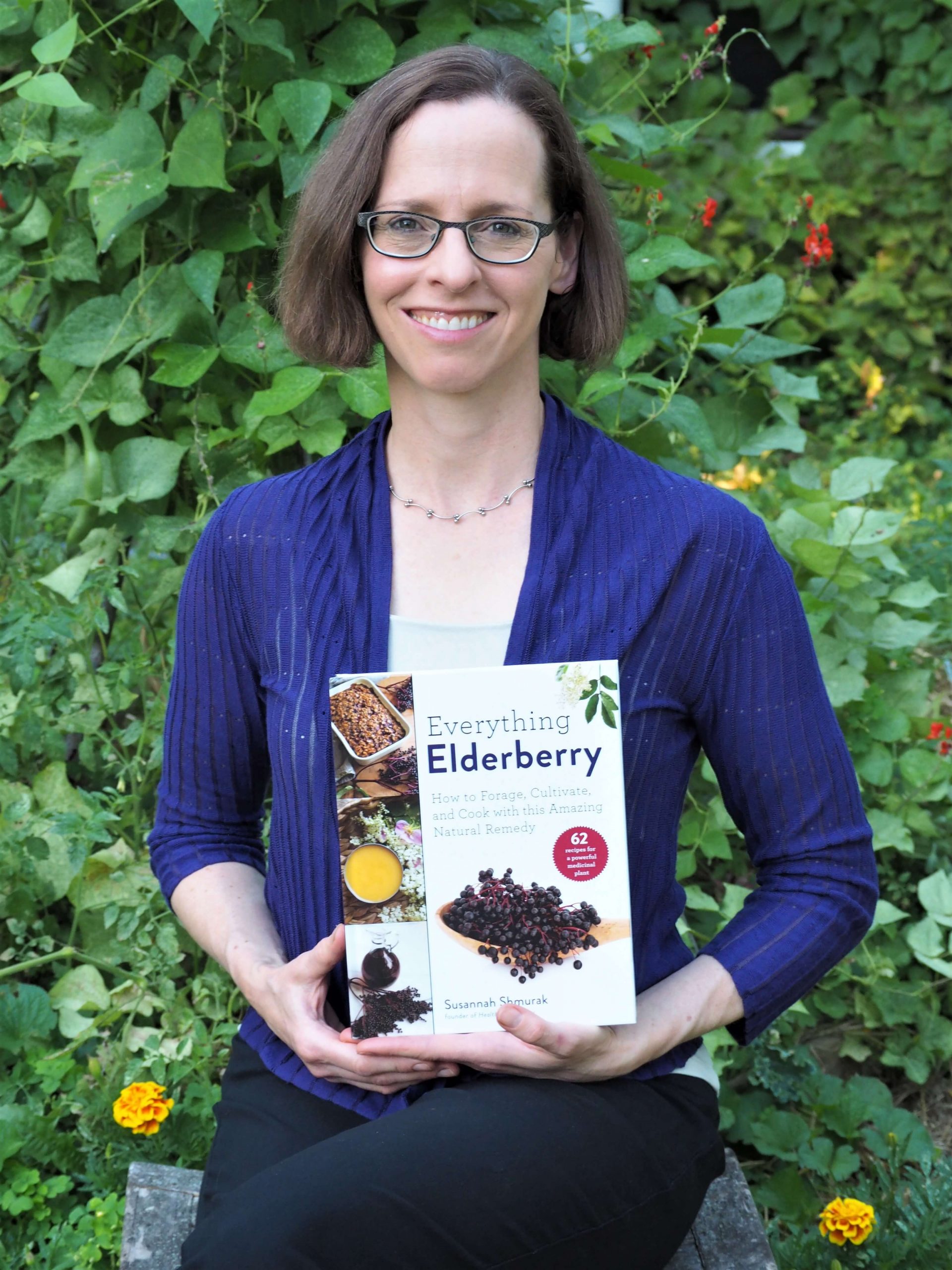Last Updated on February 14, 2025
Find out how to grow rhubarb, a super-easy perennial vegetable that will reward you with years of delicious fruit!
We’re all about easy here at HealthyGreenSavvy, and I can’t think of anything easier than growing rhubarb! Like magic, this gorgeous plant emerges every spring, no matter how many feet of snow may have buried it in the 5-6 months of Minnesota’s winter.
Here’s what you need to know about growing rhubarb — plus many reasons you’d want to!

Growing Rhubarb for Easy Spring Garden Wins
As a time-strapped gardener, I lean hard on perennial food plants, which do their thing with precious little intervention. I make sure they’re watered, and I feed them some compost from time to time, but other than that, they do all the work and we get all the reward. Not very fair, I suppose, but such a great deal for the busy gardener!
And when most of my garden plants are just peeking out of the soil, super-early rhubarb is booming along and ready for harvest. With our ridiculously long winter and our annoyingly short growing season, those early crops are super-important!
Rhubarb is one of dozens of perennial vegetables you can consider adding to your garden. Here’s more on using permaculture principles to get more food for less work.
Related: How to Grow More in a Small Garden
Why Consider Growing Rhubarb?
Why would you want to grow rhubarb, a slightly odd veggie that most people treat as a fruit? Besides being a striking landscape plant, rhubarb is absolutely delicious in so many recipes!
Technically a vegetable, rhubarb is low in calories and high in nutrients like vitamin K and potassium, which most of us don’t get enough of. Rhubarb has a delightfully tart flavor that tastes amazing in quick breads and crisps, as well as in numerous savory dishes. (Here’s my nearly failproof rhubarb crisp recipe. SO good and even reasonably healthy as desserts go.)
We grow FIVE EIGHT rhubarb plants in our tiny edible yard because we’re raving fans of the incredible homemade fruit leather you can make from rhubarb, so we use rhubarb in immense quantities.
But even if you’re not going to plant huge amounts of rhubarb for fruit leather, I urge you to consider this wonderful addition to your garden. It can be tucked into any landscape as a beautiful accent plant, or it can sit at one end of your veggie patch, where it will help hold your soil when all your annual vegetables have petered out.
And then you can enjoy it at whatever pace works for your family, adding it to your baking or making rhubarb ice cream, or whatever suits your fancy. You may well find you want more plants sooner than you think!
How to Grow Rhubarb: Getting Starter Plants
Rhubarb comes in green, pink and red. Greener plants tend to be more vigorous and yield more, and red is thought to be sweeter. I have something in the middle, and I think it’s great! A pleasant pink when cooked, with nice fat stalks that are easy to chop.
Sweetness isn’t what we’re after with rhubarb, anyhow. Rhubarb’s main attraction is its signature tart flavor.
You can find a starter rhubarb plant (called a crown) at your local nursery or garden center (or even online). But I recommend saving your money, since it should be pretty easy to get a rhubarb plant for free.
If you’re a frugal gardener like myself, you’ll be thrilled to learn your first rhubarb plant doesn’t have to cost you a cent. Like many other perennials, rhubarb can easily be divided, and chances are someone in your neighborhood will be more than happy to dig some up for you.
Here’s what to know about how to find and get free plants for your garden from other gardeners in your area.
If your rhubarb division is from a local source, you’ll know it does well in your climate. If you’re buying online, be sure to find a variety suited to your growing zone. Some rhubarb plants will grow in zones as low as 3, while others won’t tolerate cold that extreme. Rhubarb is a northern plant, though, and needs winter temperatures below 40 degrees. If you’re in the south, look for a variety that can grow below zone 8. Some southern rhubarb fans grow their rhubarb as annuals during the cooler months, as it can’t survive the extreme heat of southern summers.
Rhubarb is best divided in early spring, when the plant is still dormant, but you can also do it in late fall.
Rhubarb plants like to be divided every 3-5 years, so gardeners with established rhubarb plants will be digging up their rhubarb periodically anyhow.
If you don’t have access to free rhubarb divisions and don’t want to buy crowns, you can also grow rhubarb from seed, though the plant you’ll get may be a bit different from the parent plant and you’ll wait a bit longer to start harvesting rhubarb stalks.
You can either buy rhubarb seeds or save them from flower stalks that don’t get taken off. (More on this below — it’s best to remove flowers to allow rhubarb to put its energy into growing stalks, but you can let one go if you want to harvest seed. You’ll get plenty from just one flower.)
Getting Rhubarb Starts from Plant Divisions
In early spring, dig up established rhubarb and slice through to separate the plant into clusters of 3-4 buds to replant. Each cluster of buds can become a new plant.
Replant immediately, incorporating plenty of compost and giving it a good soaking. If you’re not getting right into the ground, soak your division in a bucket of water. Here’s a helpful video to show you the process of dividing rhubarb:
Growing Rhubarb: Soil & Siting
Rhubarb is pretty tolerant of most kinds of soil, though it likes a good deal of organic matter and decent drainage. Mine’s always managed pretty well in our clay-ey soil.
Its preferred pH is 5.5-6.5. You can check pH with one of these nifty soil meters, which also can measure moisture and sun exposure.
Rhubarb is one of the vegetables that grow in shade, though it will produce more and bigger stalks in full sun.
Planting Rhubarb
To plant rhubarb starts, dig a large hole and backfill with soil mixed with several shovelfuls of compost or composted manure. Place your rhubarb root 1-2″ below the soil surface. Give your rhubarb plant a good soaking and mulch well to conserve moisture.
Rhubarb plants should be placed at least 4 feet apart.
If you’d like to try companion planting, here are some rhubarb companion plants to consider.
Rhubarb Plant Care
Keep your rhubarb plant watered consistently, especially while it’s getting established. Rhubarb plants want at least 1″ of water each week.
When you see a flower stalk start to shoot up, cut it off with a sharp knife. You want the plant to put its energy into its stalks rather than into producing seeds, unless you’ve decided to let one go so you can grow rhubarb from seed.
Turns out rhubarb flowers are edible if you want to try using them as a bonus crop from your rhubarb patch.
When you tuck in your rhubarb for winter, give it a nice dressing of compost to help it get off to a good start in the spring.
Harvesting Rhubarb
Do not pick any of your rhubarb the first year. You want to let it get established first.
The second year pick it only lightly, taking just a few stalks from each plant. After that, have at it!
I’ve read some people leave only a few stalks when they pick, and I’ve read that you should only harvest a third. Rhubarb is such a tough plant, I think it’s up to you. I tend to pick the biggest stalks and leave the rest, coming back for more every week or so. Keeping the plant picked helps extend its season.
Stalks are ready to harvest when they’re at least a foot long. It’s generally easier to work with thicker stalks in the kitchen. If stalks are thin, your plant is probably not getting enough sun or needs more nutrients in the soil (or both). Apply additional compost, and consider moving the plant to a sunnier location.
To harvest stalks, twist off at the base of the plant. Pick only about a third to half of a mature plant.
NOTE THAT RHUBARB LEAVES ARE POISONOUS. They have toxic levels of oxalic acid, so be sure to remove the leaves completely. You can lay them around the base of your plant for extra weed suppression. Some sources suggest that frost can send some of the oxalic acid into the stalks, so best to pick what you want before the frost.
Here’s more on the question ‘Are rhubarb leaves poisonous?‘ as well as uses for them in the garden.
If you pick from your rhubarb plant regularly, the stalks should stay tender and usable throughout the season. Otherwise, once summer begins to heat up, stalks begin to toughen. They can still be cooked and pureed, but they will be far more stringy.
If you want to save some rhubarb for later in the season, gather it all up before it toughens and pop it in the freezer. Here’s what you need to know about how to freeze rhubarb.
Here’s information on the easiest food preservation methods for wanna-be preservers without a lot of extra time to master the more involved methods.
What to Do with Rhubarb
♦ Make homemade fruit leather!
♦ Use rhubarb sauce as a topping for ice cream or homemade yogurt. Or just eat it plain — it’s awesome!
♦ Make rhubarb crisp, crumble, or cobbler. Or pie, if that’s your thing.
♦ Rhubarb muffins and quick breads are utterly divine.
♦ Rhubarb juice makes a wonderfully refreshing drink, and it’s a bonus leftover from rhubarb sauce or fruit leather. Add it to cocktails or lemonade or seltzer water.
–> You can find links to these recipes and more in my collection of rhubarb recipes here.
Do you grow rhubarb? What’s your favorite way to use it?
Here are some other favorite crops and garden strategies:
- How to Grow Spinach
- How to Grow Spaghetti Squash
- Edible Landscaping 101: Growing Fruit
- How to Grow Garlic
- How to Grow Melons in Cool Climates
- 9 Ways to Grow Food in a Small Garden
Pin to save this info on how to grow rhubarb!
How to grow rhubarb photo credits: kaboompics, Hans, PDerrett, daseaford

Susannah is a proud garden geek and energy nerd who loves healthy food and natural remedies. Her work has appeared in Mother Earth Living, Ensia, Northern Gardener, Sierra, and on numerous websites. Her first book, Everything Elderberry, released in September 2020 and has been a #1 new release in holistic medicine, naturopathy, herb gardening, and other categories. Find out more and grab your copy here.



 Hi, I'm Susannah, a garden geek, energy nerd, and fan of healthy food and natural remedies. Need some simple, practical solutions for living healthier and greener? You've come to the right place! More about me and my green projects
Hi, I'm Susannah, a garden geek, energy nerd, and fan of healthy food and natural remedies. Need some simple, practical solutions for living healthier and greener? You've come to the right place! More about me and my green projects